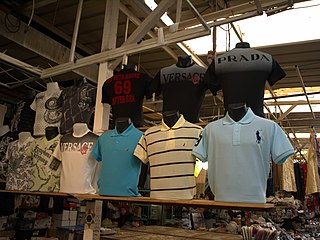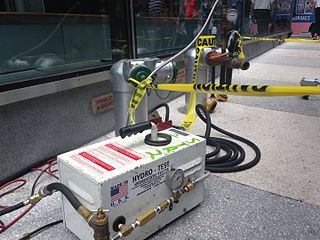
To counterfeit means to imitate something authentic, with the intent to steal, destroy, or replace the original, for use in illegal transactions, or otherwise to deceive individuals into believing that the fake is of equal or greater value than the real product. Counterfeit products are fakes or unauthorized replicas of the real product. Counterfeit products are often produced with the intent to take advantage of the superior value of the imitated product. The word counterfeit frequently describes both the forgeries of currency and documents as well as the imitations of items such as clothing, handbags, shoes, pharmaceuticals, automobile parts, unapproved aircraft parts, watches, electronics and electronic parts, software, works of art, toys, and movies.

Thermoelectric cooling uses the Peltier effect to create a heat flux at the junction of two different types of materials. A Peltier cooler, heater, or thermoelectric heat pump is a solid-state active heat pump which transfers heat from one side of the device to the other, with consumption of electrical energy, depending on the direction of the current. Such an instrument is also called a Peltier device, Peltier heat pump, solid state refrigerator, or thermoelectric cooler (TEC) and occasionally a thermoelectric battery. It can be used either for heating or for cooling, although in practice the main application is cooling. It can also be used as a temperature controller that either heats or cools.

A hydrostatic test is a way in which pressure vessels such as pipelines, plumbing, gas cylinders, boilers and fuel tanks can be tested for strength and leaks. The test involves filling the vessel or pipe system with a liquid, usually water, which may be dyed to aid in visual leak detection, and pressurization of the vessel to the specified test pressure. Pressure tightness can be tested by shutting off the supply valve and observing whether there is a pressure loss. The location of a leak can be visually identified more easily if the water contains a colorant. Strength is usually tested by measuring permanent deformation of the container.

An inspection is, most generally, an organized examination or formal evaluation exercise. In engineering activities inspection involves the measurements, tests, and gauges applied to certain characteristics in regard to an object or activity. The results are usually compared to specified requirements and standards for determining whether the item or activity is in line with these targets, often with a Standard Inspection Procedure in place to ensure consistent checking. Inspections are usually non-destructive.

The Restriction of Hazardous Substances Directive 2002/95/EC, short for Directive on the restriction of the use of certain hazardous substances in electrical and electronic equipment, was adopted in February 2003 by the European Union.

Design for manufacturability is the general engineering practice of designing products in such a way that they are easy to manufacture. The concept exists in almost all engineering disciplines, but the implementation differs widely depending on the manufacturing technology. DFM describes the process of designing or engineering a product in order to facilitate the manufacturing process in order to reduce its manufacturing costs. DFM will allow potential problems to be fixed in the design phase which is the least expensive place to address them. Other factors may affect the manufacturability such as the type of raw material, the form of the raw material, dimensional tolerances, and secondary processing such as finishing.

The electronics industry is the economic sector that produces electronic devices. It emerged in the 20th century and is today one of the largest global industries. Contemporary society uses a vast array of electronic devices that are built in factories operated by the industry, which are almost always partially automated.
Electronic packaging is the design and production of enclosures for electronic devices ranging from individual semiconductor devices up to complete systems such as a mainframe computer. Packaging of an electronic system must consider protection from mechanical damage, cooling, radio frequency noise emission and electrostatic discharge. Product safety standards may dictate particular features of a consumer product, for example, external case temperature or grounding of exposed metal parts. Prototypes and industrial equipment made in small quantities may use standardized commercially available enclosures such as card cages or prefabricated boxes. Mass-market consumer devices may have highly specialized packaging to increase consumer appeal. Electronic packaging is a major discipline within the field of mechanical engineering.

Mouser Electronics, Inc., is an authorized global distributor of semiconductors and electronic components. With over $4 billion in annual revenue, Mouser is ranked as the seventh largest electronic component distributor in the world. The company has 28 locations globally and more than 4,000 employees. Mouser is part of the Berkshire Hathaway family of companies.

Newark, also called Newark Electronics, Newark element14, or Newark (an Avnet Company), is a high-service electronic components distributor serving North America and parts of Central and South America. Founded in 1934 as Newark Electric, a small Chicago shop selling radio parts, the company is the Americas division of Farnell Global (part of Avnet) and is one of the largest electronics distributor worldwide.
A gas detector is a device that detects the presence of gases in an area, often as part of a safety system. A gas detector can sound an alarm to operators in the area where the leak is occurring, giving them the opportunity to leave. This type of device is important because there are many gases that can be harmful to organic life, such as humans or animals.
Counterfeit consumer goods—or counterfeit, fraudulent, and suspect items (CFSI)—are goods, often of inferior quality, made or sold under another's brand name without the brand owner's authorization. The colloquial terms knockoff or dupe (duplicate) are often used interchangeably with counterfeit, although their legal meanings are not identical.
A Hardware Trojan (HT) is a malicious modification of the circuitry of an integrated circuit. A hardware Trojan is completely characterized by its physical representation and its behavior. The payload of an HT is the entire activity that the Trojan executes when it is triggered. In general, Trojans try to bypass or disable the security fence of a system: for example, leaking confidential information by radio emission. HTs also could disable, damage or destroy the entire chip or components of it.
The Professional Electrical Apparatus Reconditioning League or PEARL is an international professional organization and standards group based in Denver, Colorado. PEARL is focused on developing ethical business practices and technical standards related to inspecting, testing, and reconditioning circuit breakers, transformer, motor controls, switchgear, disconnect switches, protective relays, bus duct, motor starters and other electrical equipment and apparatus used in the electrical distribution systems of commercial, industrial, and utility facilities.
Ultrapure water (UPW), high-purity water or highly purified water (HPW) is water that has been purified to uncommonly stringent specifications. Ultrapure water is a term commonly used in manufacturing to emphasize the fact that the water is treated to the highest levels of purity for all contaminant types, including: organic and inorganic compounds; dissolved and particulate matter; volatile and non-volatile; reactive, and inert; hydrophilic and hydrophobic; and dissolved gases.
Onto Innovation Inc. is an American semiconductor company formed in 2019 from the merger of Rudolph Technologies, Inc. and Nanometrics Incorporated. Onto Innovation is traded as NYSE: ONTO on the New York Stock Exchange, it is a provider of process and process control equipment and software for microelectronic manufacturing industries. The company's product offering includes automated defect inspection and metrology systems, probe card test and analysis systems, and lithography step-and-repeat systems. In addition, Onto Innovation provides a broad range of software products designed to improve yield, control processes and reduce manufacturing costs.
Robustness validation is a skills strategy with which the Robustness of a product to the loading conditions of a real application is proven and targeted statements about risks and reliability can be made. This strategy is particularly for use in the automotive industry however could be applied to any industry where high levels of reliability are required

N.F. Smith & Associates, also known as Smith, or Smith & Associates, is an independent distributor of electronic components and semiconductors headquartered in Houston, Texas.
IEC Electronics Corp. was set up in 1966 and now is based in Newark, New York. The company focuses on electronic contract manufacturing services (EMS), such as the circuit cards, loads of cable and wire harness assemblies, and precision sheet metal components, for military, aerospace, medical devices, and other industry markets. In addition, the company provides services like testing and detection of counterfeit electronic parts, component risk mitigation and advanced failure analysis. IEC Electronics acquired Southern California Braiding, Inc. in 2010 to further develop IEC’s subsidiary, IEC Electronics Wire and Cable, Inc.. The company also has another subsidiary, namely Albuquerque. In October 2021, the company was acquired by Creation Technologies.
Rochester Electronics, LLC is a privately owned American technology company headquartered in Newburyport, MA, United States that manufactures and globally distributes semiconductors that are either obsolete or nearing the end of their product lifecycle. The company is authorized by over 70 semiconductor manufacturers and is licensed to manufacture and distribute semiconductors that are no longer produced by the original manufacturer.









